The riparian ecosystem is easily characterized. “Riparian” is not only a term that has to do with plant classification, but also describes anything that is by a river. This is an important concept in other fields as well, such as water rights. Plants belonging to this characterization have one major thing in common: a need for water. Compared to chaparral or desert plants, riparian plants are much less drought tolerant. While some may do well with minimal water, it is usually a good idea to have a stream or wash in the area to supply them with enough water to keep their foliage looking its best. In California, riparian plants are found throughout the state and they do well in several different sun conditions from some needing almost full shade, to some tolerating full sun at all times. In terms of soil composition, riparian plants diverse in their needs. Some do well in clay or loamy soils while others need a well-draining sandy or rocky soil.
Given the extremely rocky conditions in the Scott Hall lawn area, those of the latter type do very well here. In the case of our garden, it is important to note that there are several plants in our Riparian Garden, as well as all of our gardens, that may not be considered strictly riparian. The reason for this was a desire to have a flow to the garden rather than strict division. This gives the gardens a more natural look: on the edge of various ecosystems, there will be a species of two from the adjoining ecosystem. This seems to be especially the case in riparian systems which often run directly through other ecosystems. This occurs quite often with oak woodland species which is why the Western Redbud and the Fuchsia Flowered Gooseberry are included in both the riparian and the oak woodland gardens. Overall, our Riparian Garden includes some very interesting plants. From the ‘Emerald Carpet’ Manzanita Hybrid, which is a deep green ground cover, to the California sycamore, which can grow to 50 feet or taller, our garden has a variety of plants which compliment our overall garden plan.
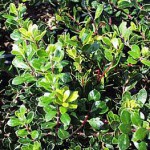 Common Name: Manzanita Hybrid
Common Name: Manzanita Hybrid
Latin Name: Arctostaphalos ‘Emerald Carpet’
Habitat: This hybrid does especially well on the northwestern coast but with watering, can do well in quasi-drought areas.
Soil composition: ‘Emerald Carpet’ can do well either in relatively sandy or loamy soil, though it is thought that a lightly loamy soil is best. This type of soil not only provides the Manzanita with sufficient nutrients to maintain its lush green color, but also has adequate draining.
Watering: Can be considered drought tolerant in the northwest, but in very dry areas should be watered 1-3 times per week, depending on season.
Light: Can handle partial shade and may even do better with it in very hot and dry conditions, but should have a healthy amount of sun.
Size: This hybrid rarely grows higher than 1 foot tall, but can extend out to a width of 4-6 feet, making it a substantial ground cover plant.
Appearance: Has very deep green leaves which can be yellowish in nutrient-poor soil. Has cinnamon colored bark, which is often hidden by the dense foliage.
The ‘Emerald Carpet’ cultivar was developed at the nearby Rancho Santa Anna Botanical Gardens, and serves well as either a drought resistant ground covering, or as a separator species between two varying garden themes. It is a hybrid of Kinnikinnick and Glossyleaf Manzanita. It inherits its deep green color from the later, and its hardiness from the former.
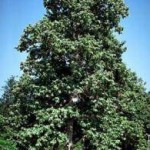 Common Name: California Sycamore
Common Name: California Sycamore
Latin Name: Platanus racemosa
Native Habitat: From Baja to the Sacramento Valley, including parts of the Sierra Nevada range.
Soil composition: Coarse and well-draining sandy rocky soil.
Water: Needs at least weekly watering
Light: Full sun
Height x Width: Can grow up to 100 feet tall, as well as being up to five feet in diameter, including its multiple trunks.
The California Sycamore is a tree found to dominate many stream ecosystems in California. It needs plentiful water, and can display drought stress when deprived. This tree is somewhat known for its “delicate” foliage, and the ground below it will often be covered by its leaves. Its trunk is smooth and light colored.
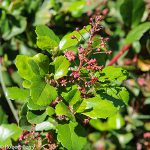 Common Name: Evergreen Currant
Common Name: Evergreen Currant
Latin Name: Ribes viburnifolium
Native Habitat: Baja California, and Santa Catalina Island
Soil Composition: Clay rich soil to well drained.
Water: Can handle less water in a clay soil, but can be watered once to twice a month regardless.
Light: Full to partial shade
Height x Width: Normally 3 feet high but can grow as high as 6 feet. Can be used as a ground cover.
The Evergreen Currant has rich green foliage, though it can burn with too much sun and should therefore be planted either in a shady area or under a large tree. However, when in shade it is quite drought tolerant, and with the right soil can be simply watered monthly. Also known as the Catalina Currant, it is common on Santa Catalina Island although it is also found in Baja, and sometimes in San Diego County.
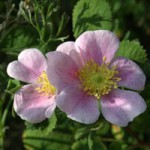 Common name: California Wild Rose
Common name: California Wild Rose
Latin Name: Rosa californica
Native Habitat: California Floristic Province below 6000 feet.
Soil composition: Can be grown in varying soil compositions.
Water: Prefers to have moist soil, but can be moderately drought tolerant.
Light: Partial shade to partial sun.
Height x Width: 3-6 feet tall, can vary in width.
The California wild rose grows throughout the state and can be found in thickets near water sources. It displays pink flowers as well as red fruit, and can provide cover for some birds.
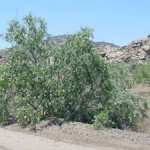 Common Name: Desert Willow ‘Art’s Seedless’
Common Name: Desert Willow ‘Art’s Seedless’
Latin Name: Chilopsis linearis ‘Art’s Seedless’
Natural Habitat: Desert areas from Southern California to Southwestern Texas. Along desert creeks and washes.
Soil Composition: Decomposed granite, clay loam, sand, well drained, can accommodate to varying soil conditions.
Water: Depending on season either weekly or bi-weekly.
Light: Full sun
Height x Width: Usually from 15-30 feet tall, and has a trunk of about 6 inches in diameter.
This tree, or, as it is sometimes known, upright shrub, is an indicator of shallow surface water during the wet season. It bears 3-8 inch long brown pods, and has pink-purple flowers with white frills along the edges. It is somewhat of a misnomer, as it does not actually belong to the Willow family, but instead to the Bignonia family. This is the ‘Art’s Seedless’ cultivar, and therefore will not have the typical brown pods.
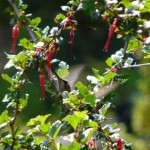 Common Name: Fuchsia Flowered Gooseberry
Common Name: Fuchsia Flowered Gooseberry
Latin Name: Ribes speciosum
Native Habitat: From Baja California North to Santa Clara.
Soil Composition: Dry, sandy, well drained soil.
Water: Once to twice a month, or none, depending on the season
Light: Full to partial shade.
Height x Width: 4-10 feet tall and 7 feet wide.
The Fuchsia Flowered Gooseberry has fuchsia flowers during the spring season. These are trumpet shaped and are good for attracting humming birds while the flowers are out. The plant has spiny stems with small red fruit. During the summer it may or may not be deciduous, depending on the level of drought stress it is under. Though it can tolerate this, it may look nicer if it is given a bit of extra water during this period of time.
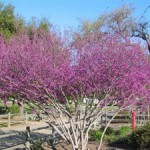 Common Name: Western Redbud
Common Name: Western Redbud
Latin name: Cercis occidentalis
Native Habitat: Inner North Coast and Klamath ranges; Sierra Nevada, Cascade and Peninsular ranges, and east to Texas
Soil: Well drained
Water: Drought tolerant to occasional
Light: Sun to partial shade
Height X Width: Maximum 20 feet x 30 feet. Usual: 20 feet x 20 feet.
Leaves or Stems: Glossy blue-green, heart-shaped, winter-deciduous.
Its reddish-purple seed pods hang on tree in winter. Likes full sun, some summer water for faster growth, regular water in desert areas. It’s tolerant of clay soils, needs a winter chill before flowers set properly. Flowers and young pods are edible.